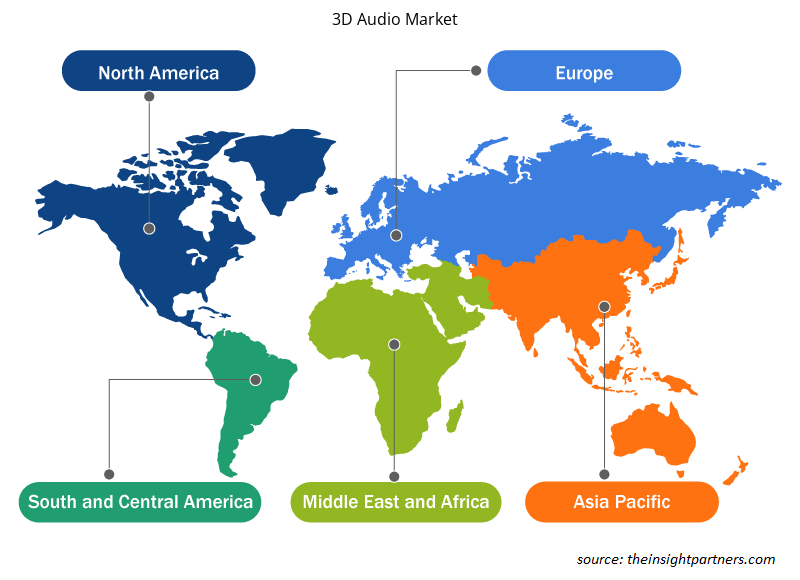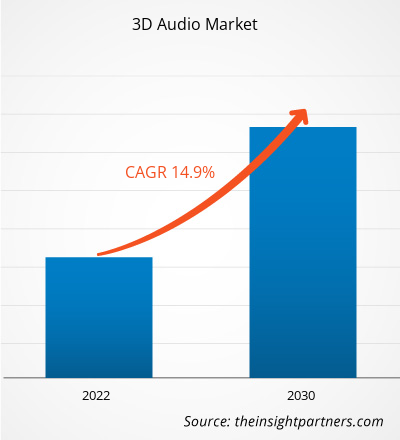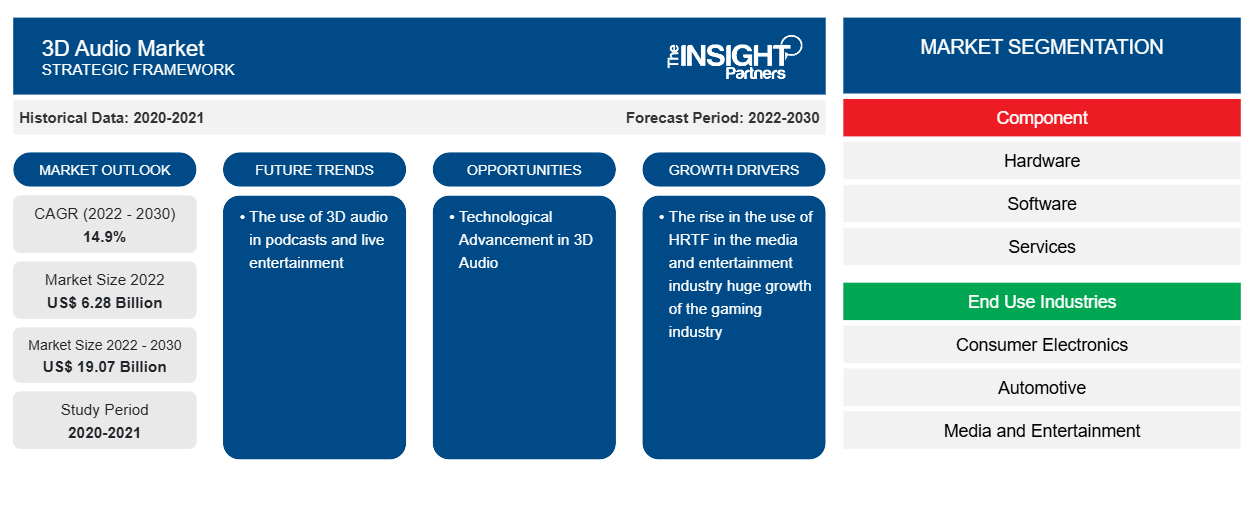[Rapporto di ricerca] Il mercato dell'audio 3D è stato valutato 6,28 miliardi di dollari nel 2022 e si prevede che raggiungerà 19,07 miliardi di dollari entro il 2030; si stima che registrerà un CAGR del 14,9% dal 2022 al 2030.
Prospettiva dell'analista del mercato audio 3D:
I continui sviluppi nel settore dei media e dell'intrattenimento e l'introduzione di moderne tecnologie AV alimentano la crescita del mercato dell'audio 3D . I produttori di audio 3D si stanno concentrando sull'incorporazione della tecnologia sound-mix nell'hardware per offrire musica (suono) migliorata agli ascoltatori in uno spazio 3D. Inoltre, la proliferazione dell'industria dei giochi sta dando impulso al mercato dell'audio 3D. Inoltre, la crescente inclinazione verso lo streaming di musica 3D online offre un'opportunità redditizia agli operatori del mercato dell'audio 3D. Inoltre, molte aziende che operano nel mercato dell'audio 3D sono coinvolte nello sviluppo di prodotti. Ad esempio, a febbraio 2023, Agora, Inc., una piattaforma pioniera e leader per API di coinvolgimento in tempo reale, ha annunciato il lancio di Agora 3D Spatial Audio; è una soluzione che consente agli sviluppatori di aggiungere audio dinamico e immersivo in esperienze digitali in tempo reale. Allo stesso modo, a gennaio 2022, Audioscenic ha stretto una partnership con Razer e THX per lanciare una soundbar desktop con tecnologia 3D Beamforming e Head-Tracking AI. Pertanto, la crescente innovazione da parte degli operatori del mercato sta alimentando la crescita del mercato dell'audio 3D.
Panoramica del mercato dell'audio 3D:
Un sistema audio 3D è un sistema acustico utilizzato per fornire agli utenti un suono in uno spazio tridimensionale. L'effetto audio 3D è un modello di diversi effetti sonori costruiti da array di altoparlanti 3D, altoparlanti stereo, cuffie e altoparlanti surround. Questi sistemi sono installati in una vasta gamma di applicazioni, come dispositivi mobili, console di gioco, sistemi audio basati su AR/VR , sistemi home theater, ecc. Inoltre, settori come automobili, elettronica di consumo e media e intrattenimento stanno implementando sistemi audio 3D per offrire un'esperienza audio 3D migliorata e visualizzazione in tempo reale ai propri utenti.
Personalizza questo report in base alle tue esigenze
Riceverai la personalizzazione gratuita di qualsiasi report, comprese parti di questo report, o analisi a livello nazionale, pacchetto dati Excel, oltre a usufruire di grandi offerte e sconti per start-up e università
-
Scopri le principali tendenze di mercato in questo rapporto.Questo campione GRATUITO includerà analisi di dati che spaziano dalle tendenze di mercato alle stime e alle previsioni.
Fattore trainante del mercato:
L'aumento dell'uso di HRTF nel settore dei media e dell'intrattenimento alimenta la crescita del mercato dell'audio 3D
L'uso di tecnologie avanzate come le funzioni di trasferimento correlate alla testa (HRTF) sta crescendo nel settore dei media e dell'intrattenimento. I player del mercato globale dell'audio 3D stanno lavorando per unire la tecnologia HRTF per migliorare l'esperienza utente. Quando si guardano film su smartphone con auricolari, l'audio 3D è più immersivo dell'audio 2D. Nel settore cinematografico, l'integrazione HRTF simula l'audio 3D quando i suoni specchiati raggiungono le orecchie da più direzioni attraverso vari altoparlanti situati su tutti e quattro i lati di uno spazio. L'HRTF è implementato per un'ampia gamma di dispositivi audio, comprese le cuffie, per fornire un'impressione di suono surround distinta. I consumatori sono sempre più interessati a installare sistemi home theater che sfruttino l'esperienza offerta da HRTF. Una certificazione chiamata Dolby Digital viene data ai consumatori che utilizzano HRTF, che si basa sugli effetti sonori surround. L'elaborazione HRTF viene anche emulata utilizzando software senza l'uso di alcun hardware esterno per produrre suono surround.
Inoltre, i produttori di cuffie stanno investendo in prodotti che integrano la tecnologia HRTF per fornire agli utenti il migliore ambiente uditivo 3D. A gennaio 2023, JBL ha ampliato le sue nuove cuffie JBL Quantum Series. Dopo il successo delle sue prime cuffie da gioco wireless, le JBL Quantum TWS, l'azienda ha anche lanciato la puntata successiva della serie, le JBL Quantum TWS Air. Pertanto, il costante aumento dell'uso di HRTF nel settore dei media e dell'intrattenimento alimenta la crescita del mercato dell'audio 3D.
Segmentazione e ambito:
Il mercato dell'audio 3D è segmentato in base a componenti, settori di utilizzo finale e geografia. In base ai componenti, il mercato è segmentato in hardware, software e servizi. Il segmento hardware è ulteriormente segmentato in altoparlanti, cuffie, microfoni e altri. In base ai settori di utilizzo finale, il mercato è segmentato in consumer, automotive, media e intrattenimento, gaming e commerciale. Inoltre, in base alla geografia, il mercato è segmentato in Europa, Nord America, Medio Oriente e Africa (MEA), Asia Pacifico (APAC) e Sud America (SAM).
Analisi segmentale:
In base ai componenti, il mercato dell'audio 3D è suddiviso in hardware, software e servizi. Altoparlanti, cuffie, altoparlanti Bluetooth, microfoni , sound bar e altri sistemi audio hardware sono inclusi nel settore hardware. I sistemi audio binaurali sono utilizzati nell'hardware audio 3D per acquisire, elaborare e riprodurre onde audio. Lo scopo del sistema hardware audio 3D è quello di fornire all'ascoltatore un'esperienza uditiva che riproduca la vita reale. Inoltre, le registrazioni audio 3D vengono effettuate utilizzando due microfoni. I microfoni raccolgono il suono in due canali contemporaneamente. Il software modifica la registrazione per imitare le piccole fluttuazioni del segnale che si verificano quando ogni orecchio trasmette messaggi al cervello e il concetto è definito biomimetica. A differenza del suono surround, che richiede l'uso di diversi altoparlanti esterni per fornire sorgenti audio direzionali, l'audio 3D può essere sperimentato solo tramite cuffie.
Analisi regionale del mercato audio 3D:
Il mercato globale dell'audio 3D è suddiviso in Nord America, Europa, MEA, APAC e SAM. Nel 2022, l'Asia Pacifica ha detenuto la quota maggiore nel mercato dell'audio 3D, seguita da Europa e America. Inoltre, si prevede che l'APAC registrerà il CAGR più elevato durante il periodo di previsione. La crescita del mercato dell'audio 3D nell'APAC è attribuita alla presenza di vari produttori di elettronica di consumo , produttori di automobili e dell'industria dell'intrattenimento nella regione, che generano un'enorme domanda di amplificatori. Inoltre, il crescente utilizzo di elettronica di consumo come televisori e smartphone, l'aumento dei livelli di reddito disponibile, la crescente adozione di dispositivi intelligenti e avanzati e la presenza di fornitori locali di audio 3D sono alcuni fattori che stimolano la crescita del mercato nella regione. La Cina detiene la quota maggiore nel mercato dell'audio 3D nell'APAC grazie alle sue elevate capacità di produzione e ai bassi costi di manodopera.
Analisi dei principali attori del mercato audio 3D:
Barco NV; Dolby Laboratories Inc; Auro Technologies; Sound Particles SA; XPERI HOLDING CORPORATION; Waves Audio Ltd; Sennheiser electronic GmbH & Co. KG; Fraunhofer; VisiSonics; e THX Ltd sono i principali attori del mercato audio 3D descritti nel rapporto.
Approfondimenti regionali sul mercato audio 3D
Le tendenze regionali e i fattori che influenzano il mercato dell'audio 3D durante il periodo di previsione sono stati ampiamente spiegati dagli analisti di Insight Partners. Questa sezione discute anche i segmenti e la geografia del mercato dell'audio 3D in Nord America, Europa, Asia Pacifico, Medio Oriente e Africa e Sud e Centro America.

- Ottieni i dati specifici regionali per il mercato audio 3D
Ambito del rapporto sul mercato audio 3D
| Attributo del report | Dettagli |
|---|---|
| Dimensioni del mercato nel 2022 | 6,28 miliardi di dollari USA |
| Dimensioni del mercato entro il 2030 | 19,07 miliardi di dollari USA |
| CAGR globale (2022-2030) | 14,9% |
| Dati storici | 2020-2021 |
| Periodo di previsione | 2022-2030 |
| Segmenti coperti |
Per componente
|
| Regioni e Paesi coperti |
America del Nord
|
| Leader di mercato e profili aziendali chiave |
|
Densità dei player del mercato audio 3D: comprendere il suo impatto sulle dinamiche aziendali
Il mercato del mercato audio 3D sta crescendo rapidamente, spinto dalla crescente domanda degli utenti finali dovuta a fattori quali l'evoluzione delle preferenze dei consumatori, i progressi tecnologici e una maggiore consapevolezza dei vantaggi del prodotto. Con l'aumento della domanda, le aziende stanno ampliando le loro offerte, innovando per soddisfare le esigenze dei consumatori e capitalizzando sulle tendenze emergenti, il che alimenta ulteriormente la crescita del mercato.
La densità degli operatori di mercato si riferisce alla distribuzione di aziende o società che operano in un particolare mercato o settore. Indica quanti concorrenti (operatori di mercato) sono presenti in un dato spazio di mercato in relazione alle sue dimensioni o al valore di mercato totale.
Le principali aziende che operano nel mercato dell'audio 3D sono:
- Barco NV
- Laboratori Dolby Inc.
- Tecnologie Auro
- Particelle sonore SA
- Società per azioni XPERI
- Onde Audio Ltd
Disclaimer : le aziende elencate sopra non sono classificate secondo un ordine particolare.

- Ottieni una panoramica dei principali attori del mercato audio 3D
Sviluppi recenti del mercato dell'audio 3D:
Gli operatori del mercato audio 3D adottano ampiamente strategie inorganiche e organiche. Di seguito sono elencati alcuni recenti sviluppi chiave del mercato:
- Nel 2023, CEVA ha acquisito Spatial Audio Business da VisiSonics per ampliare il suo portafoglio di software applicativi per sistemi embedded destinati ai dispositivi indossabili e ad altri mercati IoT consumer.
- Nel 2023, Xperi Inc. ha annunciato una partnership con LG Electronics per integrare la tecnologia audio immersiva DTS:X negli ultimi televisori OLED e Premium LCD di LG. DTS, Inc., una sussidiaria interamente controllata da Xperi Inc., si impegna a migliorare il suono del mondo attraverso le sue soluzioni audio pionieristiche per dispositivi mobili, casa e cinema, tra gli altri.
- Nel 2023, NEWAURO BV, uno dei principali fornitori di tecnologia audio immersiva per sistemi di intrattenimento domestico di nuova generazione, ha presentato la sua nuova piattaforma di sistema soundbar al Consumer Electronics Show di Las Vegas. La soluzione completamente integrata include la più recente tecnologia di virtualizzazione degli speaker Auro-Scene. Consente ai produttori di dispositivi di creare sistemi soundbar avanzati che vanno da stereo a 7.1.4, incluso il supporto per speaker satellite configurabili.
- Nel 2023, Dolby Laboratories, uno dei leader nelle esperienze di intrattenimento immersive, ha presentato la sua ultima innovazione nell'audio immersivo: Dolby Atmos FlexConnect. TCL, un marchio TV leader a livello mondiale, sarà il primo a implementare Dolby Atmos FlexConnect nella sua gamma TV del 2024.
- Nel 2022, THX Ltd. e VisiSonics, leader nelle tecnologie audio spaziali 3D che migliorano le prestazioni degli utenti finali e ottimizzano gli ambienti acustici, hanno annunciato che THX ha ottenuto in licenza alcune tecnologie audio e di personalizzazione 3D da VisiSonics e le sta incorporando nei suoi prodotti. Le tecnologie VisiSonics vengono utilizzate negli strumenti THX Spatial Audio per sviluppatori di giochi e produttori musicali e per la personalizzazione audio THX avanzata per i produttori di cuffie.
- Nel 2021, Dolby Laboratories ha annunciato che Dolby Atmos farà parte del nuovo sistema Surreal Sound a 21 altoparlanti di Lucid Air, offrendo un'esperienza di ascolto davvero coinvolgente insieme a funzionalità di sicurezza audio attive avanzate per l'auto.
- Nel 2021, Auro Technologies ha annunciato che Yamaha offrirà il suo formato audio 3D AURO-3D sui suoi più recenti sistemi di ricevitori AV AVENTAGE.
- Nel 2021, AURO Technologies ha rilasciato AURO-3D Creative Tools Suite 3.0. L'ultima versione di Creative Tools Suite offre un'intera serie di nuove funzionalità. Il processo di accesso a tutte le funzionalità principali di Creative Tools Suite diventa più semplice, consentendo un lavoro fluido in AURO-3D.
- Nel 2021, Fraunhofer IIS, lo sviluppatore principale dello standard MPEG-H 3D Audio, ha annunciato che Sony Corporation (Sony) ha ottenuto la licenza per il software MPEG-H 3D Audio Baseline Profile Decoder di Fraunhofer e ha aderito al programma MPEG-H Trademark.
- Analisi storica (2 anni), anno base, previsione (7 anni) con CAGR
- Analisi PEST e SWOT
- Valore/volume delle dimensioni del mercato - Globale, Regionale, Nazionale
- Industria e panorama competitivo
- Set di dati Excel
Report recenti
Rapporti correlati
Testimonianze
Motivo dell'acquisto
- Processo decisionale informato
- Comprensione delle dinamiche di mercato
- Analisi competitiva
- Analisi dei clienti
- Previsioni di mercato
- Mitigazione del rischio
- Pianificazione strategica
- Giustificazione degli investimenti
- Identificazione dei mercati emergenti
- Miglioramento delle strategie di marketing
- Aumento dell'efficienza operativa
- Allineamento alle tendenze normative























 Ottieni un campione gratuito per - Mercato audio 3D
Ottieni un campione gratuito per - Mercato audio 3D